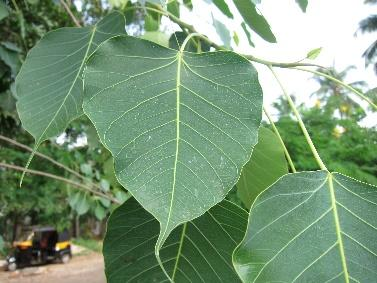
Which plant shows reticulate venation?
(A) Ficus
(B) Canna
(C) Musa
(D) Zea
Answer
498.9k+ views
1 likes
Hint:Reticulate venation is seen in Dicot plants. Veins are repeatedly branched to form a network in leaves with reticulate venation.
Complete answer:
Venation: The mode of arrangement of veins and veinlets in the leaf lamina is called venation. Venation is of two type- reticulate and parallel venation. In reticulate venation, the veins are repeatedly branched to form a network. It is a characteristic feature of dicot plants. e.g.: Hibiscus, Mango tree, etc.
In parallel venation, the veins run parallel to one another from the midrib to the margins or from the base to apex. It is a characteristic feature of monocot plants. e.g.: Grasses, banana. Etc.
In the given plants Ficus is a dicot plant and Canna, Musa, Zea are monocot plants. Therefore, plants showing reticulate venation is Ficus.

Fig: Reticulate venation in Ficus
Thus, option (A) is the correct answer.
Additional informations
Functions of vein
Veins form the skeleton of the leaf-blade and give rigidity to the leaf. Veins help the leaf-blade to keep flat , so that it may be evenly illuminated by the sunlight.
Veins distribute water and mineral salts received from the stem throughout the leaf-blade, collect the prepared food material from the blade and send it to the stem and other parts of the plants.
Note:Branched veins and veinlet are the characteristic feature of leaf with reticulate venation. Reticulate venation is in plants belonging to Dicots. Parallel venation is seen in Monocot plants.
Complete answer:
Venation: The mode of arrangement of veins and veinlets in the leaf lamina is called venation. Venation is of two type- reticulate and parallel venation. In reticulate venation, the veins are repeatedly branched to form a network. It is a characteristic feature of dicot plants. e.g.: Hibiscus, Mango tree, etc.
In parallel venation, the veins run parallel to one another from the midrib to the margins or from the base to apex. It is a characteristic feature of monocot plants. e.g.: Grasses, banana. Etc.
In the given plants Ficus is a dicot plant and Canna, Musa, Zea are monocot plants. Therefore, plants showing reticulate venation is Ficus.

Fig: Reticulate venation in Ficus
Thus, option (A) is the correct answer.
Additional informations
Functions of vein
Veins form the skeleton of the leaf-blade and give rigidity to the leaf. Veins help the leaf-blade to keep flat , so that it may be evenly illuminated by the sunlight.
Veins distribute water and mineral salts received from the stem throughout the leaf-blade, collect the prepared food material from the blade and send it to the stem and other parts of the plants.
Note:Branched veins and veinlet are the characteristic feature of leaf with reticulate venation. Reticulate venation is in plants belonging to Dicots. Parallel venation is seen in Monocot plants.
Recently Updated Pages
Master Class 11 Economics: Engaging Questions & Answers for Success

Master Class 11 Business Studies: Engaging Questions & Answers for Success

Master Class 11 Accountancy: Engaging Questions & Answers for Success

Master Class 11 English: Engaging Questions & Answers for Success

Master Class 11 Computer Science: Engaging Questions & Answers for Success

Master Class 11 Maths: Engaging Questions & Answers for Success

Trending doubts
State and prove Bernoullis theorem class 11 physics CBSE

1 ton equals to A 100 kg B 1000 kg C 10 kg D 10000 class 11 physics CBSE

State the laws of reflection of light

One Metric ton is equal to kg A 10000 B 1000 C 100 class 11 physics CBSE

1 Quintal is equal to a 110 kg b 10 kg c 100kg d 1000 class 11 physics CBSE

Difference Between Prokaryotic Cells and Eukaryotic Cells




